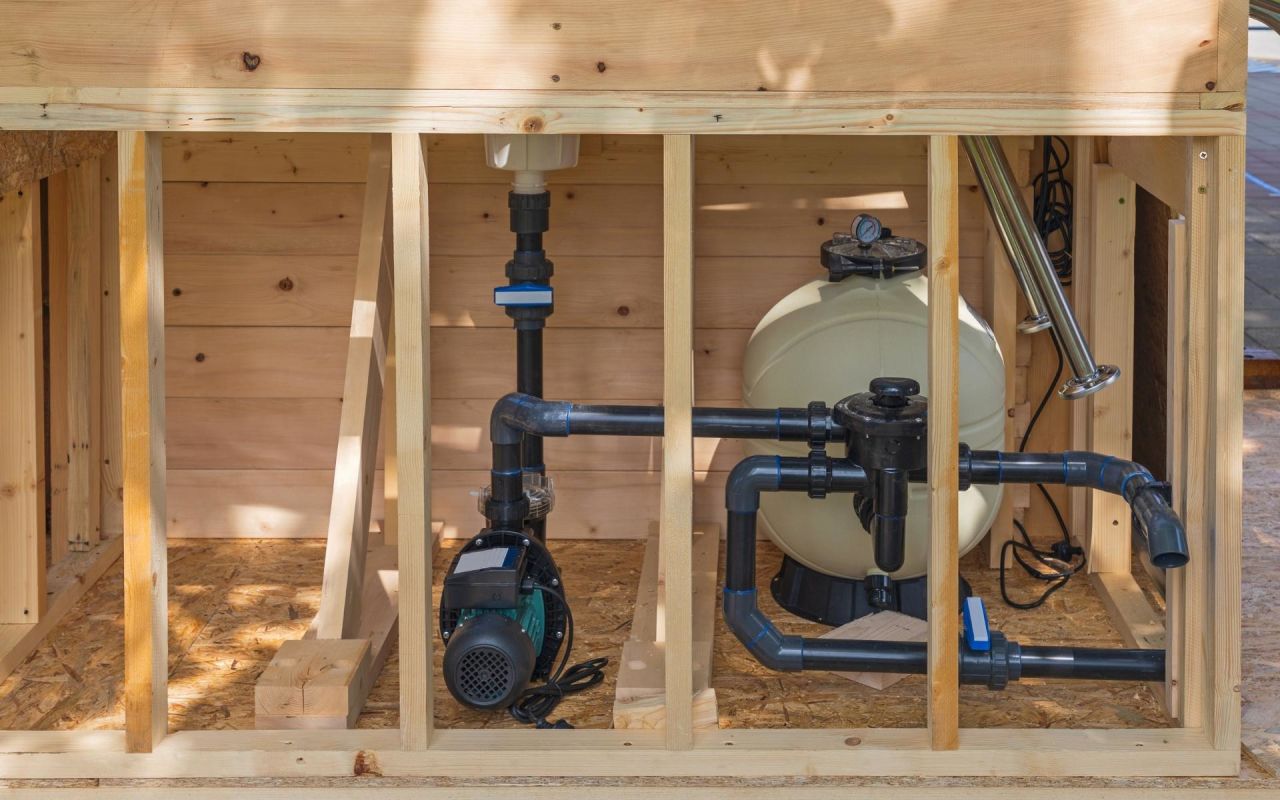Havuz Pompası Nasıl Çalışır

Havuz Pompası Nasıl Çalışır
Emme işlemi: Havuz pompası, suyu emen ve pompa sistemine yönlendiren bir emiş parçasına sahiptir. Bu kısımda büyük su partiküllerinin geçişini engelleyen ve pompanın zarar görmesini engelleyen filtre bulunmaktadır.
Pompalama işlemi: Havuz pompası emme kısmından aldığı suyu basınçlandırmak için bir pompalama mekanizması kullanır. Bu basınçlandırma işlemi, suyu havuz boruları ve filtre sisteminden geçirir. Bu, suyun arıtılmasını ve sirkülasyonunu sağlar. Filtrasyon işlemi: Havuz pompasında pompa mekanizmasının hemen arkasında filtre sistemi bulunmaktadır. Bu filtreler sudaki kir, yaprak, böcek ve diğer partikülleri tutar. Bu sayede havuzdaki su arıtılır ve kalitesi korunur.
İade işlemi: Pompalanan su filtre sisteminden geçtikten sonra havuzun dönüş borusuna geri döndürülür. Dönüş hattı, suyu havuza geri döndüren borular ve duşlardan oluşmaktadır. Duşlar, suyu havuz boyunca eşit olarak dağıtarak sirkülasyonu sağlar.
Sürekli kullanım: Havuz pompası genellikle sürekli çalışır veya programlanabilir bir zamanlayıcıya sahiptir. Böylece havuzdaki su sürekli sirküle olur ve temiz kalır. Pompaların çalışma süresi havuzun büyüklüğüne, kullanım yoğunluğuna ve suyun kalitesine göre değişiklik gösterebilmektedir.
Havuz pompası havuzdaki kirli suyu filtreler, suyu tekrar sirküle eder ve temiz su üretir. Bu sayede havuzunuzun su kalitesini koruyabilir ve kullanımı daha keyifli hale getirebilirsiniz.
Havuz Pompasının Günlük Çalışma Süresi
Havuz büyüklüğü kullanım yoğunluğu, hava koşulları ve su kalitesi gibi faktörlere bağlı olarak değişiklik gösterebilmektedir. Genel olarak havuz pompasının günlük kullanım süresi 6-8 saat olabilmektedir. Bu süre, sürekli havuz sirkülasyonu sağlamak ve suyu temiz tutmak için yeterli olabilir.
Ancak kullanımın fazla olduğu veya havaların sıcak olduğu bölgelerde günlük kullanım süresinin uzatılması gerekebilir. Ayrıca, su kalitesini korumak için filtrasyon süresi uzatılabilir. Bazı havuz sahipleri, temizlik verimliliğini artırmak için pompayı günde iki kez kısa sürelerle çalıştırmayı tercih edebilir.
Havuzunuzun özellikleri ve ihtiyaçları için en uygun kullanım süresini belirlemek için havuz üreticisi veya havuz bakımcısı ile iletişime geçmeniz önemlidir. Ayrıca havuz pompasının programlanabilir bir zamanlayıcısı varsa, çalışma süresini ayarlamak ve optimize etmek daha kolay olabilir.
Havuz pompası ürünlerini ve fiyatlarını görmek için tıklayınız.
Havuz pompasının hava yapmasının birkaç olası nedeni vardır
Havuz seviyesi: Havuz pompası su emerek çalışır. Havuz su seviyesi çok düşükse veya pompaya yeterince su akmıyorsa, pompa hava çekebilir. Bu durumda havuzdaki su seviyesini kontrol ederek ve gerekirse su ekleyerek pompanın hava almasını engelleyebilirsiniz.
Hava Sızıntıları: Havuz pompası ve filtre sistemindeki açıklıklarda veya vanalarda hava sızıntısı olabilir. Bu kaçaklar pompa emiş hattına hava girmesine ve pompanın hava üretmesine neden olabilir. Sızıntı olup olmadığını kontrol ederek ve gerekirse contaları değiştirerek bu sorunu çözmek mümkün olabilir.
Kirli veya Tıkalı Filtre: Havuz filtresi kirli veya tıkalıysa su akışı engellenebilir ve pompada hava birikebilir. Bu durumda filtrenin temizlenmesi veya gerekirse filtrenin değiştirilmesi gerekir.
Pompa Kapağı: Havuz pompası kapağı doğru takılmazsa veya muhafaza zarar görürse pompa hava çekebilir. Bu sorunu çözmek için pompa kapağını kontrol edin ve gerekirse değiştirin. Pompa emiş hattında tıkanıklık: Pompa emiş hattında tıkanıklık olabilir. Yapraklar, çamur veya diğer parçacıklardan kaynaklanabilirler. Bir tıkanıklık su akışını engelleyebilir ve pompanın hava emmesine neden olabilir. Emme borusunu kontrol edip temizleyerek bu sorunu çözmek önemlidir.
Su pompasının basıncının düşmesinin birkaç olası nedeni vardır
Hava kaçağı: Su pompasının emiş veya basınç hatlarında hava kaçağı olabilir. Bu, suyun verimli bir şekilde pompalanmasını engeller ve basınçta düşüşe neden olur. Hava kaçaklarını kontrol etmek ve kaçakları onarmak önemlidir.
Tıkanma veya Tıkanma: Su pompasının emme veya basma borusunda tıkanıklıklar olabilir. Yapraklar, çamur veya diğer parçacıklar gibi malzemeler suyun serbest akışını engelleyebilir ve basınçta düşüşe neden olabilir. Emiş borusunu ve filtreleri kontrol ederek, tıkanıklıkları gidererek veya gerekirse filtreleri değiştirerek bu sorunu çözebilirsiniz.
Pompa arızası: Su pompasının içindeki mekanizmaların arızalanması basınç düşmesine neden olabilir. Örneğin, pompa pervanesindeki hasar veya aşınma, suyun düzgün şekilde pompalanmasını engelleyebilir. Pompa mekanizmalarının kontrol edilmesi ve gerekirse onarılması veya değiştirilmesi önemlidir.
Filtre sorunları: Havuz pompasına bağlı filtre sisteminde sorun olabilir. Kirli veya tıkalı bir filtre, su akışını kısıtlayarak basınçta düşüşe neden olabilir. Gerekirse, filtrenin temizlenmesi veya filtrenin değiştirilmesi gerekebilir.
Elektrik sorunları: Su pompasının elektrik beslemesiyle ilgili sorunlar, pompaların düzgün çalışmasını etkileyebilir. Düşük voltaj veya bağlantı sorunları yetersiz pompa gücüne ve basınç düşüşüne neden olabilir. Elektrik bağlantılarını kontrol etmek ve gerekirse profesyonel bir elektrikçiden yardım istemek önemlidir.
Su Pompası Bozulursa Ne Olur?
Bir su pompası arızasının havuz üzerinde çeşitli zararlı etkileri olabilir. Su pompası arızalandığında ortaya çıkabilecek bazı sorunlar şunlardır:
Düşük su sirkülasyonu: Su pompası havuzdaki suyu sirküle eder. Pompada bir arıza olursa su sirkülasyonu yavaşlar veya durur. Bu durumda havuzdaki su durgun kalır, kir ve partiküller birikir ve suyun kalitesi bozulabilir. Aynı zamanda suyun eşit olarak karışmaması da sorunlara neden olabilir. Su saflığı ile ilgili sorunlar: pompa arızası filtrasyon sürecini etkiler. Filtrelemeyi azaltmak veya durdurmak havuzun temizliğini etkileyecektir. Suda kir, yaprak, böcek ve diğer parçacıklar toplanır ve su bulanık veya kirli hale gelir.
Kimyasal Dengesizlik: Bir su pompası, havuz kimyasallarının eşit şekilde dağılmasına yardımcı olur. Pompada bir arıza olursa kimyasal denge bozulabilir. Örneğin, klorun yetersiz dağılımı, suyun mikroorganizmalara karşı korumasını zayıflatabilir ve suyu sağlıksız hale getirebilir.
Basınç sorunları: Bir su pompası arızası, basınç sorunlarına neden olabilir. Basınç düşebilir veya yükselebilir, bu da sistemin dengesini bozar. Alçak basınç düzgün su sirkülasyonu sağlamazken, yüksek basınç pompa üzerinde aşırı baskıya ve aşırı enerji tüketimine neden olabilir.
Enerji verimliliği: Arızalı bir su pompası enerji verimliliğini olumsuz etkileyebilir. Örneğin pompa merdanesi aşınması veya kaçakları pompadan su sızarak enerji kayıplarına neden olur. Bu, daha yüksek enerji faturalarına ve daha yüksek işletme maliyetlerine yol açabilir.
